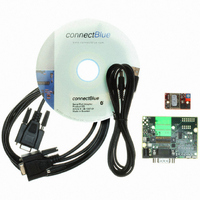CB-OWSPA311GI-01 ConnectBlue, CB-OWSPA311GI-01 Datasheet - Page 15

CB-OWSPA311GI-01
Manufacturer Part Number
CB-OWSPA311GI-01
Description
KIT START OEM WIRELESS LAN RS232
Manufacturer
ConnectBlue
Series
OEM Serial Port Adapter™r
Type
Bluetoothr
Datasheet
1.CB-OEMSPA311I-01.pdf
(60 pages)
Specifications of CB-OWSPA311GI-01
Frequency
2.4GHz
Lead Free Status / RoHS Status
Lead free / RoHS Compliant
Other names
809-1018
Key Management
5.4 Important Behavior
Cache
Ad-hoc and Roaming
Note: The OWSPA311g will not indicate any errors if you enter an invalid combination.
There are a few important considerations that need to be addressed as well. If you choose
WPA/WPA2 PSK and TKIP, this is considered a WPA connection. If you choose WPA/WPA2 PSK
and AES/CCMP, a WPA2 connection is assumed. It is not possible to have WPA with AES/CCMP
encryption.
If you wish to use LEAP as the authentication algorithm, make sure that your access point sup-
ports it. Not all access points support LEAP.
Neither LEAP nor WPA/WPA2 PSK will work in ad-hoc mode.
For WEP64 and WEP128 shared keys can be entered into all four possible slots made available
by the AT*AGFPWI Write Encryption/Authentication Key (with Index) command. However, for
LEAP and WPA/WPA2 PSK the password or PSK must be entered into key slot with index 1
(one). This key must also be the one currently set active by the AT*AGAFP Active Encryp-
tion/Authentication Key command.
If you are using LEAP, the username for the Radius server should be entered with the command
AT*AGUN Username.
If you are using WPA/WPA2 PSK you can enter either the pre-shared key (i.e. the hexadecimal
string) or the password (plain-text), commonly referred to as “WPA-PSK” and “WPA-PWD”.
Each time you change the password you need to reboot the OWSPA311g for the settings to
take effect. If you choose to enter a password (not a hexadecimal string) the OWSPA311g will
take slightly longer during the first boot after this change, in order to deduce the real key from
the password. When the OWSPA311 is calculating the real key it will be unresponsive.
When a module is not connected to any remote peers it cannot transfer any incoming data on
the UART to any remote devices. Instead it tries to cache the data. This will happen in any of
these cases: if there are no remote peers configured, if the module is trying to connect to a re-
mote peer or if a single remote peer uses the “Connect on data” connection scheme. The data
is cached until a connection to a remote peer is established. The cache is implemented as 256
bytes FIFO. If the FIFO gets full before the module has established a connection, the oldest data
is silently discarded.
Ad-hoc networks operate without any access point. This makes them versatile and well suited
for small and improvised networks setup on the fly. However, since there is no access point in
the network, one of the devices in the ad-hoc network will assume the role of a basic access
point.
Therefore, if a module wanting to connect to an ad-hoc network cannot find an existing net-
work with the correct SSID, it will take the role of the access point. Any devices looking for the
network after this will find the network and can properly connect to it.
If the module that has the role of the access point for some reason leaves the network (due to
power failure or moving out of range) another device in the network will automatically assume
the role of the access point and this will keep the network going.
Version 1.6.6 - 2009-11
15




















